Boeing successfully flies fuel cell-powered airplane
03 April 2008
For the first time in aviation history a manned airplane powered by hydrogen fuel cells has been successfully test flown.
 Boeing Research & Technology Europe (BR&TE) in Madrid, with assistance from industry partners in Austria, France, Germany, Spain, the United Kingdom and the United States, conducted three test flights in of a manned airplane powered by hydrogen fuel cells.
Boeing Research & Technology Europe (BR&TE) in Madrid, with assistance from industry partners in Austria, France, Germany, Spain, the United Kingdom and the United States, conducted three test flights in of a manned airplane powered by hydrogen fuel cells.
A fuel cell is an electrochemical device that converts hydrogen directly into electricity and heat without the effects of combustion, such as carbon dioxide. Other than heat, water is its only exhaust.
Boeing says the research is a part of its efforts to improve the environmental performance of aerospace products.
A two-seat Dimona motor-glider with a 16.3 meter (53.5 foot) wingspan was used as the airframe. Built by Diamond Aircraft Industries of Austria, it was modified by BR&TE to include a Proton Exchange Membrane (PEM) fuel cell / lithium-ion battery hybrid system to power an electric motor coupled to a conventional propeller.
During the flights, the pilot of the experimental airplane climbed to an altitude of 1,000 meters (3,300 feet) above sea level using a combination of battery power and power generated by hydrogen fuel cells. After reaching the cruise altitude and disconnecting the batteries, the pilot flew straight and level at a cruising speed of 100 kilometers per hour (62 miles per hour) for approximately 20 minutes on power solely generated by the fuel cells.
